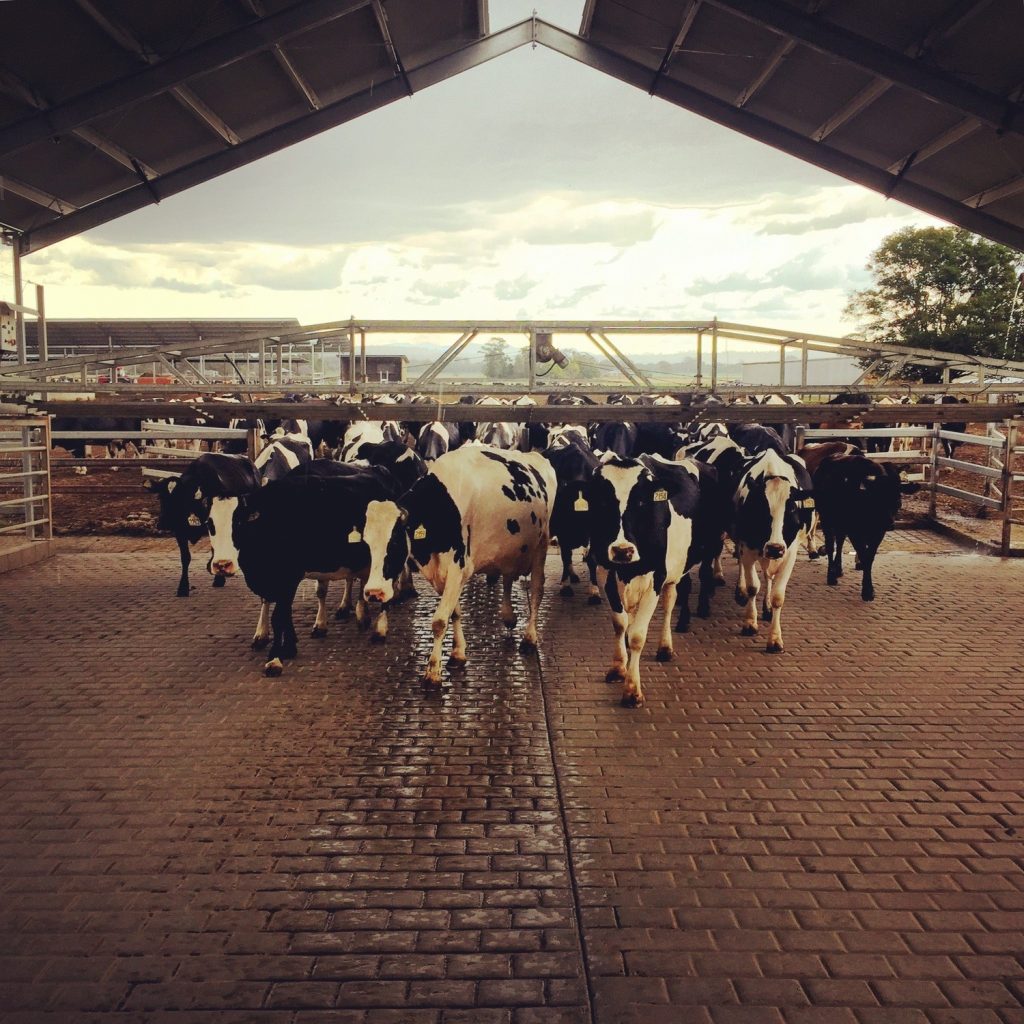
That’s removed some volatility from markets, with cheese and milk prices settling at relatively stable, but also relatively low, levels as domestic commercial use of milk in all products drop to nearly flat levels of growth and increases in exports also slow.
The Dairy Margin Coverage program margin dropped below the maximum $9.50 per cwt coverage level to deliver a final monthly payment for 2020 of $0.72 per cwt in December, bringing the average payments for the maximum coverage level during all of 2020 to $0.73 per cwt. Payouts under the program, the main federal safety net for dairy producers, are expected for most of this year.
With year-end data now reported, the annual average U.S. all-milk price for 2020 was $18.30 per cwt, 30 cents below 2019. But with the uncharacteristically high level of direct CFAP payments and payment disparities due to the high level of Class III milk depooled from federal orders last year, the all-milk price is less reflective of average farmer revenues than typical. Also, the number of licensed U.S. dairies declined to 31,657 in 2020, a decrease of 7.5 percent from the previous year. That is slower than the loss rate in 2019 but still above historical averages.
Commercial Use of Dairy Products
Sales of fluid milk from September through December returned to the longer-term historical trend of small declines that was interrupted during the early months of the pandemic.
On a 3-month moving average basis, year-over-year change in total fluid milk use was consistently negative from the end of 2009 until the onset of the pandemic in March last
year. During that more than 10-year period, fluid use was down from a year earlier by an average of 1.8 percent.
Then from March 2020 through August, 3-month YOY change was consistently positive and averaged 1.2 percent. On the same, 3-month moving average basis, the 2020 domestic consumption trends for other consumer products are: yogurt, consistently positive, averaging 5.6 percent; butter, strongly positive, averaging 10.3 percent, from April through August, then basically flat, on average, for the rest of the year; cheese, negative, averaging -2.2 percent, through June, then spiking quickly positive in July and slowly falling off and ending down in December; all dairy products, milk equivalent total solids basis, consistently negative, averaging -1.7 percent, through August, then consistently positive, averaging 0.7 percent, but dropping off during the fourth quarter.
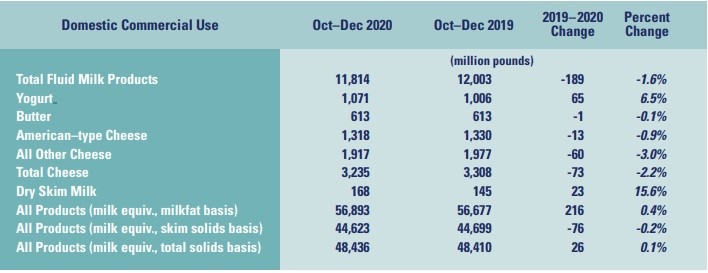
U.S. Dairy Trade
Total exports in 2020 were up by 12.3 percent in milk equivalent over 2019, which was enough to push up total consumption for the year by 1.1. percent as it offset declines in total domestic consumption of all dairy products, milk equivalent, which fell by 0.8 percent. This included most government purchases under the Food Box and other programs. Total exports represented 15.7 percent of total consumption during 2020. Despite falling to a bit below a year ago in November and December, due largely to container shortagerelated shipment delays from U.S. ports, this percentage growth for the year was a record for a calendar year, just beating 2018’s 15.4 percent. Milk solids exported as a percent of total U.S. milk solids production was also a record in 2020, at 16.0 percent, just ahead of 2018’s 15.8 percent.
For all of 2020, total imports of all dairy products, milk equivalent, were 3.3 percent below 2019.
Milk Production
Total U.S. milk production was 2.8 percent above a year earlier during the fourth quarter of 2020. Compared with growth of total commercial use in the domestic and export markets of just 0.1 percent during the period, this provided a recipe for prices to fall at the end of 2020 and for prices and margins to stay depressed for the near future. Cow numbers were up over a year earlier by 82,000 during the fourth quarter.
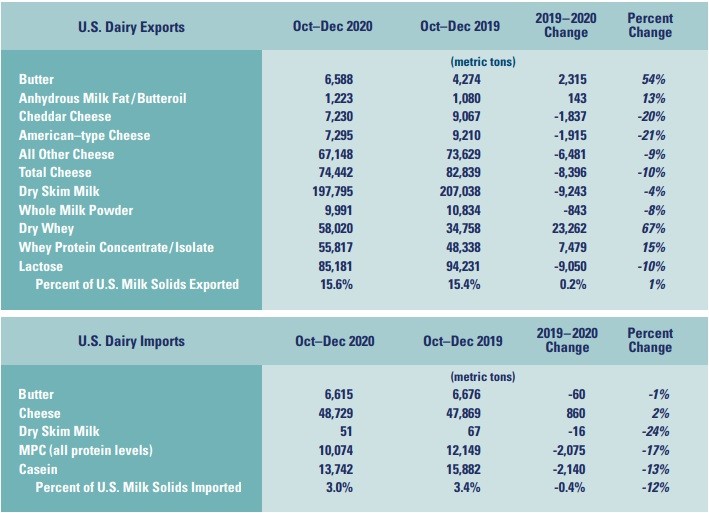
Dairy Products
Fourth quarter production data indicates that the additional milk coming from U.S. dairy farms is flowing heavily into American-type cheese and butter and nonfat dry milk production. Lower production of other types of cheese and of skim milk powder would appear to reflect, respectively, lower food service use during the fall pandemic surge and reduced skim milk powder exports during the last months of 2020.
Dairy Product Inventories
Commercial stocks of the major dairy products were mostly higher at the end of 2020, as would be expected by comparing the fourth quarter production and commercial use data. Butter stocks were in excess of typical days of total commercial use for the month of December by two weeks. But stocks of butter, both types of cheese and dry skim milk were all lower than the levels they reached during the initial onslaught of the pandemic last April and May.
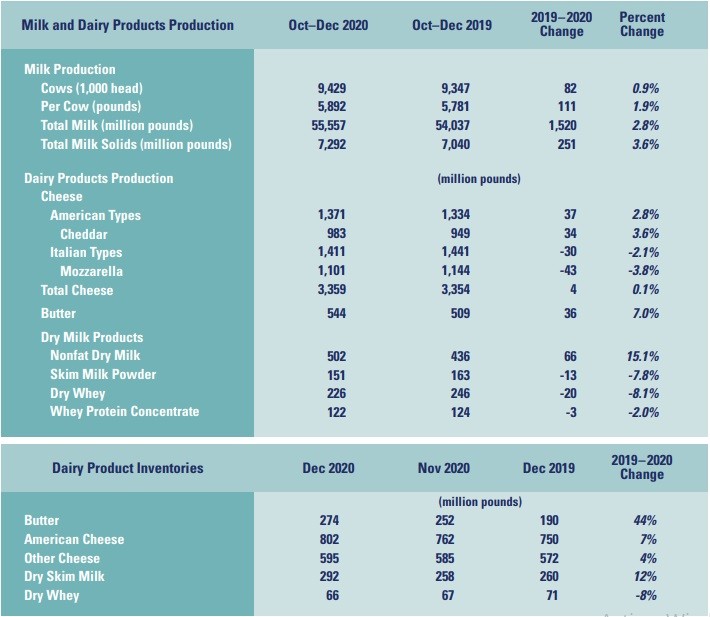
Dairy Product and Federal Order
Class Prices
Monthly average survey prices for cheese were relatively stable from December to January, after having fallen from their November highs. January prices for nonfat dry milk continued to show the steady improvement they have experienced starting last May, while dry whey prices have continued to increase since last September. Both have benefitted from, and been driven by, improvements in world market prices for dry skim milk and whey products during the pandemic.
Monthly survey prices for butter have pulled back from the highs in the $1.70s they reached last June and July.
The monthly Class III and Class IV prices for January and December reflect the respective price movements of cheese and butter/nonfat dry milk during those months, while the January advance-priced Class I mover reflected the drop in cheese prices from November to December.
Retail prices for fluid milk remained relatively stable during the months bracketing the turn of the year, following a rise of more than 10 percent from last summer. Retail prices for cheddar cheese had remained relatively constant since last summer, but then rose by more than 10 cents a pound in the new year. Retail butter did basically the same, starting back in late summer last year.
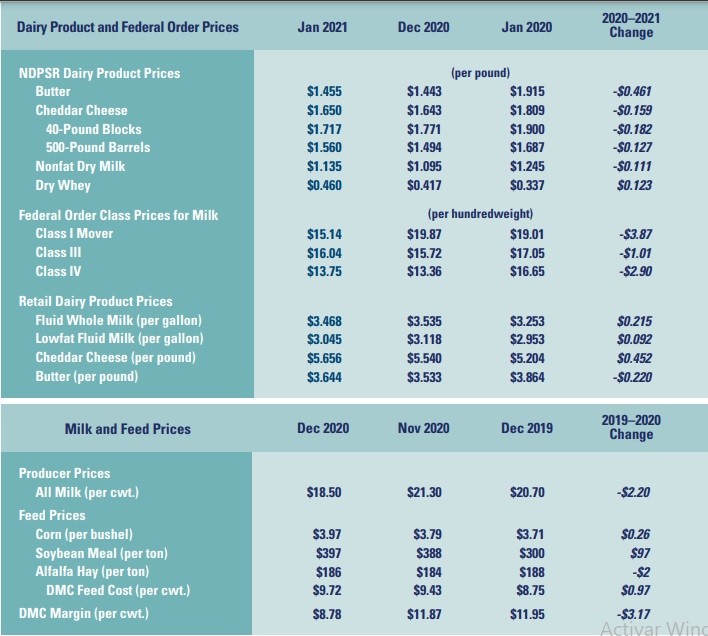
Milk and Feed Prices
The December DMC margin fell by $3.09 per cwt from its November high to $8.78 per cwt, which generated a final 2020 montly payment of $0.72 per cwt for coverage at the maximum $9.50 per cwt level. Average payments for all of 2020 at this coverage level were $0.73 per cwt. Deconstructed into its individual components, the November to December change in the margin, on a per hundredweight of milk basis, was: milk price, -$2.80; corn price, +$0.19; soybean meal price, +$0.07; alfalfa hay price, +$0.02 (totals don’t add due to rounding).
Looking Ahead
The futures markets in late February are predicting an annual average all-milk price of around $18.00 per cwt for 2021. The current USDA World Agricultural Supply and Demand Estimates forecast was $17.15 per cwt, which was down by 50 cents from January’s forecast. The DMC Decision Tool is currently offline, but with the monthly price outlook remaining below $18.00 per cwt for the first half of the year and feed costs closing in on $10.00 per cwt, DMC margins are expected to result in significant payments for $9.50 coverage for the foreseeable future.
